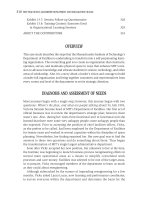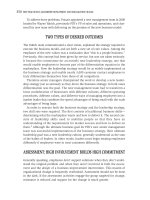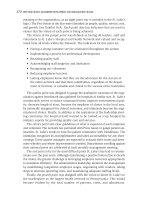Tài liệu Best Practives in Leadership Development & Organization Change 48 pdf
Bạn đang xem bản rút gọn của tài liệu. Xem và tải ngay bản đầy đủ của tài liệu tại đây (138.16 KB, 10 trang )
DESIGN AND IMPLEMENTATION 445
Table 19.7: Content That Was Most Emphasized
in Training Initiatives, in Order of Frequency of Use 446
Table 19.8: Specific Content Most Emphasized within
Training Interventions, in Order of Percentage Frequency 447
Table 19.9: Key Factors for Leadership Development
and Change, in Order of Frequency of Use 447
Table 19.10: Other Key Factors Indicated by Best
Practice Organizations 448
EVALUATING THE OD/HRD INITIATIVE 448
Table 19.11: Evaluation Method Usage 450
Table 19.12: Positive Results of Initiatives, in Order
of Percentage Frequency 450
SUMMARY 450
NOTES 451
COMPANY AND INITIATIVE BACKGROUND
The organizations appearing in this book vary in the number of employees, rev-
enues, and industries. Industries represented throughout this book are aero-
space, consulting services, consumer products, electronics, financial services,
higher education, hospitality and restaurants, information technology, manu-
facturing, and telecommunications. Respondents come from different divisions,
including commercial services, corporate, facilities, human resources, manu-
facturing, and science and technology, among others.
BUSINESS DIAGNOSIS AND ASSESSMENT
The greatest compliment that was ever paid me was when one asked me
what I thought, and attended to my answer.
—Henry David Thoreau
1
Prior to embarking on any initiative to change some aspect of organizational
culture, each organization engaged in diagnosis, using a customized needs
assessment to further determine the most prudent course of action. The initial
step of assessing guarantees that initiatives and interventions are well thought
out and planned. Needs assessment provided organizations, its leaders,
440
BEST PRACTICES IN LEADERSHIP DEVELOPMENT AND ORGANIZATION CHANGE
cart_14399_ch19.qxd 10/19/04 1:20 PM Page 440
employees, and customers the opportunity to uncover specific issues and
perspectives on change.
Diagnosis for our best practice organizations considered the increasing num-
bers of competitors from a growing global marketplace, fluctuating economic
conditions, and the rise and fall of industries. Another challenge organizations
are facing is the realization and acknowledgement of the importance of cus-
tomers in their decision-making processes and potentially a more important
stakeholder—the employee.
Best practice organizations used a variety of methods to measure the need for
their initiatives. These methods ranged from observation of work practices and
employee behavior to more concrete and less subjective measures such as sur-
veys, focus groups, and performance appraisals. The later methods helped reduce
the number of alternate hypotheses that were made by the program designers
and also served to reinforce the perceptions of senior management and program
designers’ use of observation techniques. Surveying and appraisals took the
form of several instruments in the assessment phase, including 360-degree
assessment, multirater assessment instruments, and various individual assess-
ment instruments.
The diagnosis and assessment phase of the best practice leadership develop-
ment and change programs proved to be an excellent method of gaining support
and marketing the initiative. By better understanding the learning and change
needs of participants, organizations became more knowledgeable and more able
to adapt to the changing needs and demands of its participants and employees.
The results of the assessment instruments often formed the basis of the training
programs and other specific company change initiatives.
Assessment methods in the “Other” category ranged in depth of diagnostic
techniques from financial performance to quality indicators to employee
turnover to and customer feedback to comments from board members.
CONCLUSION
441
Table 19.1. Top Five Reasons Organizations Made the Business
Case for the Initiative, in Order of Frequency
Business Case Frequency
Productivity needs 1
Competitive pressures 2
Consumer needs 3
Growth 4
Corporate vision 5
cart_14399_ch19.qxd 10/19/04 1:20 PM Page 441
RESISTANCE TO CHANGE
You have to have confidence in your ability, and then be tough
enough to follow through.
—Rosalynn Carter
2
In thinking about the forces of change—technology, economics, competition,
social and cultural, and the changing workforce, including diversity and skills
levels—it seems that every organization is in a constant state of change. One
of the most challenging obstacles to overcome in any organizational transfor-
mation effort is the resistance encountered during change. Resistance can be
due to any combination of factors, including psychological, technological, or
cultural fears, security or economic concerns, or fear of the unknown, to name
a few. Of those who responded, the most prevalent obstacles to implement-
ing the initiative were difficulty in gaining consensus from disparate parties
(40 percent of respondents) and maintaining that managers are accountable
for following through with action items (33 percent of respondents). Survey
data also showed that 27 percent responded to having difficulty with each of
the following items: implementing change in different regions of the world,
achieving project sponsorship, assisting employees in applying new tech-
nologies and applications, and others, including continued learning and sus-
taining the focus on the initiative. All organizations reported some type of
resistance.
442
BEST PRACTICES IN LEADERSHIP DEVELOPMENT AND ORGANIZATION CHANGE
Table 19.2. Assessment Methods by Frequency of Use
Assessment Methods Frequency of Use
Observation 1
Surveys 2
Interviews 3
Focus groups 4
Meetings 5
Performance appraisals 6
Other 7
Survey box/opinions 8
cart_14399_ch19.qxd 10/19/04 1:20 PM Page 442
REDUCING RESISTANCE
You cannot shake hands with a clenched fist.
—Indira Gandhi, 1982
3
Although resistance is often viewed as negative, it was often viewed positively
by our best practice organizations to help to guide the design and development
of the leadership development and change initiatives. Employees presenting
opposing viewpoints, or what some call “pushback,” were instead perceived as
a sound-board and sometimes as a “balancing system” for the organization. Of
course, a critical mass of supporters are necessary for any change initiative. The
challengers to the system, however, have proven to be important in balancing
systems that are too synchronous or closed in their decision-making processes.
Challengers serve to clarify and bring more awareness of the initiative to the
organization. It was proven through our best practice contributors that chal-
lengers are healthy to the system in this way. Employees need to be reassured
that positive change is not something to fear but instead something to be
embraced for the organization. As described by Richard Beckhard in his model
for resistance
First steps (F) ϫ (multiplied by) Vision (V) ϫ Dissatisfaction (D)
Ͼ (is greater than or overcomes) Resistance (R)
It is therefore important to have stable and visible senior leadership that is sup-
portive of the changes taking place, a clear picture of what is going to be accom-
plished as a whole system, step-by-step approaches to achieve change, and a
clear understanding throughout the organization of the dissatisfaction, so that
the entire organization is aware of what needs to be changed for the greater
good.
CONCLUSION
443
Table 19.3. Types of Resistance Encountered, in Order of Percentage
Frequency Encountered
Types of Resistance Frequency
Fear of change, the unknown, and loss of control 1
Time constraints 2
Negative reaction to “soft skills” training 3
Negative reaction to failed prior initiatives 4
Sense of mistrust 5
cart_14399_ch19.qxd 10/19/04 1:20 PM Page 443
Because of the need for consistency in senior leadership support, we asked
our contributing organizations which ways organizational leaders showed sup-
port for the initiative. Results indicated that leadership makes significant
attempts and gestures to model behavior, quell fears, and work with funding
sources.
The organizations within this book clearly make the choice to treat people
with dignity, understanding, and respect while balancing organizational needs
and objectives. And they are aware that the truth of one individual is not nec-
essarily “the Truth but simply one person’s wisdom. Organizations in this book
clearly understand that employees are adult learners with various and diverse
positions, needs, interests, learning styles, personality styles, levels of intellec-
tual development, and thinking styles (see Table 19.6).
444
BEST PRACTICES IN LEADERSHIP DEVELOPMENT AND ORGANIZATION CHANGE
Table 19.4. Top Champions of Change in the Companies Initiative, in Order
of Percentage Frequency
Change Agents Frequency (%)
President and chief officers 73
Senior executives 60
OD, HRD, training, strategy, implementation team 33
Entire organization 13
Driven jointly by managers 7
Table 19.5. Top Critical Success Behaviors of Senior Leadership for the
Initiative, in Order of Percentage Frequency
Behavior Frequency (%)
Allocates funds for the initiative 93
Models behavior consistent with strategy 73
Integrates initiative into strategic plan 60
Facilitates education or training 47
Participates in education and training 73
Articulates case for change 67
Ties compensation to initiative 27
cart_14399_ch19.qxd 10/19/04 1:20 PM Page 444









